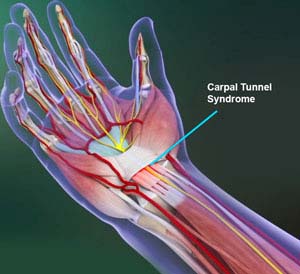
What is Carpal Tunnel Syndrome?
Carpal tunnel syndrome is a common, painful, progressive condition that is caused by compression of the median nerve at the wrist area.
Symptoms of Carpal Tunnel Syndrome
The common symptoms of carpal tunnel syndrome include numbness and tingling sensation in all the fingers except the little finger, pain and burning sensation in your hand and wrist that may radiate up the forearm and elbow, and weakness in your hand.
Causes of Carpal Tunnel Syndrome
The exact causes of the condition are not known. However, certain factors increase the risk of developing carpal tunnel syndrome:
- Congenital abnormalities
- Repetitive motion of hand and wrists
- Fractures and sprains
- Hormonal imbalance
- Medical conditions such as
- Hypothyroidism
- Rheumatoid arthritis
- Diabetes
- Obesity
- Gout
- Overactive pituitary gland
- Presence of a cyst or tumor in the carpal tunnel
Conservative Treatment Options for Carpal Tunnel Syndrome
Carpal tunnel syndrome may be treated using conservative approaches. The conservative treatments include:
- Treating the underlying medical conditions
- Immobilization of the wrist with a splint at night or during activity
- Rest the hand for 2 weeks or more
- Avoid activities that tend to worsen the symptoms
- Medications such as non-steroidal anti-inflammatory drugs and steroid injections
- Strengthening and stretching exercises once symptoms diminish
Carpal Tunnel Release Surgery
If conservative treatment options fail to resolve the condition, your surgeon may recommend surgery.
Carpal tunnel syndrome can be treated with carpal tunnel release surgery. The traditional surgery involves an incision of up to 2 inches in the palm and wrist area, whereas endoscopic surgery involves one or two half-an-inch incisions and the use of an endoscope. During the surgery, the transverse carpal ligament will be incised to release the pressure on the median nerve and enlarge the carpal tunnel. Your surgeon will decide which options are best for you based on your general and medical conditions.
Postoperative Care for Carpal Tunnel Release Surgery
Your surgeon may suggest that you follow certain postoperative instructions for better recovery and avoid further complications.
- Elevate your hand above heart level to reduce swelling.
- Wear a splint.
- Ice packs to the surgical area to reduce swelling.
- Keep the surgical incision clean and dry. Cover the area with plastic wrap when bathing or showering.
- Therapy may be ordered to restore your wrist strength.
- Eating a healthy diet and not smoking will promote healing.
Risks and Complications of Carpal Tunnel Release Surgery
Potential complications include residual pain, infection, scarring, and nerve damage causing weakness, paralysis or loss of sensation and stiffness in the hand and wrist area.
Related Topics
- Wrist Fracture
- Fractures of the Hand and Fingers
- Wrist Sprain
- Flexor Tendon Injuries
- Distal Radioulnar Joint (DRUJ) Arthritis
- Ulnar Nerve Compression in Guyon's Canal
- Scaphoid Facture
- Industrial Hand Trauma
- Distal Radius Osteotomy to Correct Mal-Union (Crooked Painful Wrist)
- Distal Intersection Syndrome
- Distal Biceps Avulsion
- Adult Forearm Fractures
- Arthritis of the Hand and Wrist
- Arthritis of the Thumb
- Ganglion Cyst
- Boutonniere Deformity
- Carpal Tunnel Syndrome
- De Quervain's Tendinosis
- Dupuytren's Contracture
- Hand Pain
- Hand Infections
- Trapeziometacarpal (TMC) Arthritis
- Wrist Injuries
- Wrist Tumors
- Boxer's Fracture
- Swan Neck Deformity
- Carpal Instability
- Bennett's Fracture
- Kienbock's Disease
- Scapholunate Dissociation
- Triscaphoid Joint Arthritis
- Ulnar Carpal Impaction
- Triangular Fibrocartilage Complex Injury (TFCC)
- Guyon's Canal Syndrome
- Hand Masses
- Distal Radioulnar Joint (DRUJ) Instability
- Work Related Hand Injuries
- Wrist Ligament Tear and Instability
- Metacarpophalangeal Joint Arthritis





